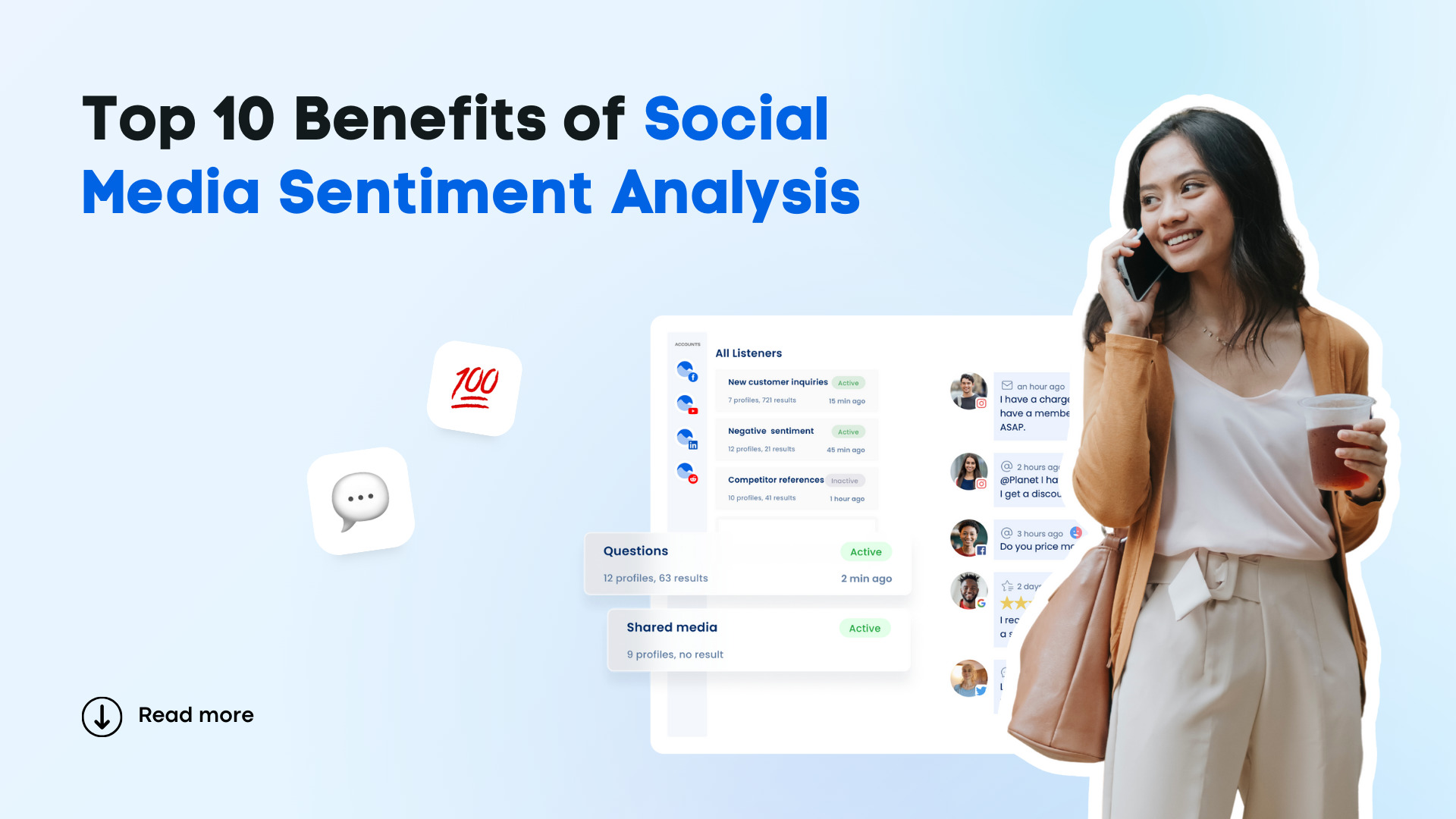Are you sick and tired of trying to guess what people think about your clients’ brands?
Social media sentiment analysis is here to save the day.
Have you ever felt like you’re flying blind when trying to uncover how people REALLY feel about your clients’ brands on social media?
You’re not alone.
Without a clear read on customer sentiment, even your clients’ amazing campaigns and most engaging posts can still miss the mark.
The good news is that there is a solution in social media sentiment analysis.
Instead of guessing whether your clients’ audiences are annoyed, hyped, or nonchalant, you can use sentiment analysis to “read the room” and respond accordingly.
In this post, we’ll go over the top ten perks of leveraging sentiment analysis to level up your social media marketing strategy and help clients connect with their audience more deeply.
What you will learn
- What are the 10 benefits of social media sentiment analysis?
- Why use Vista Social for social media sentiment analysis?
- FAQs on the benefits of social media sentiment analysis
What are the 10 benefits of social media sentiment analysis?
Understanding the advantages of social media sentiment analysis ensures you turn raw reactions into real results.
Must read: How to Perform Social Media Sentiment Analysis this 2025
Below are the top ten perks of leveraging social media sentiment analysis.
1. Go deeper into how people feel about your brand
Sentiment analysis can help you dig deeper into the sentiment behind your clients’ social media mentions, comments, and reviews to help you figure out what audiences feel.
For instance, let’s say your client’s Instagram post about a newly launched product gets 500 likes, but the comment section is packed with complaints about pricing.
With sentiment insights, you can figure out what’s wrong, address the issues promptly, and adjust your clients’ messaging.
Doing so helps ensure your clients’ messaging, customer service, etc., align better with their audiences’ emotions.
2. Get ahead of potential PR crises
If it gains traction, one negative post, Story, or Reel about your clients’ brands can spiral into a full-blown crisis.
Sentiment analysis helps you spot those warning signs early.
This way, you can resolve the issue promptly, keeping your clients’ brand reputations intact on social media.
Let’s say your client changes their return policy, and the tone of social chatter around it takes a nosedive.
Instead of finding out about it too late from a trending hashtag or scathing post, sentiment analysis tools help you flag the shift in real time.
It gives your team and clients a head start on clarifying, responding, or pivoting the messaging before things go seriously wrong.
3. Measure social media campaign impact beyond surface level metrics
Getting tons of likes and high impression rates is great, but they don’t tell how your clients’ audiences feel about their social media content.
Suppose your client launches a sustainability campaign on Facebook that generates a lot of chatter.
Sentiment analysis can track sentiment data to determine whether audiences felt skeptical, annoyed, or inspired by your client’s post.
The insight gives you the information to refine your client’s future campaigns.
It helps guide your content creation to ensure your client’s posts resonate with their audiences and drive conversions.
4. Improve content strategy based on real feedback
Maybe Gen Z audiences love your clients’ memes, but older viewers find them off-brand or plain confusing.
With sentiment analysis data, you can see and pinpoint these patterns.
For example, if your client’s TikTok carousels consistently get positive sentiment while longer videos draw lukewarm reactions, you know where you should double down.
Must read: TikTok Carousels: What Is It and How to Create One
5. Monitor brand health over time
While reputation isn’t built in a day, it can get chipped away.
By analyzing social media sentiment over time, you can clearly view your clients’ brands’ overall reputation and media presence.
For instance, after your client’s rebranding effort, you can track how their audience’s sentiment evolves weekly.
You should see whether the new look is growing on followers or missing the mark.
It’s a strategic tactic to monitor how your clients’ audiences feel about their brands, products, services, and other offerings over the long term.
6. Stay ahead of competitors
Learn how your clients’ competitors handle customer and audience feedback on social media.
You can leverage sentiment analysis to track how your clients’ audiences react to their campaigns, product launches, and customer service.
For example, you’ll know what not to do if a competitor’s new product feature is roasted on TikTok or YouTube.
Even better, you can uncover opportunities and where your clients can fill that gap and swoop in to offer customers a more fitting alternative or solution.
7. Improve customer service response
Not every unsatisfied customer tags or mentions your clients’ brands on their Instagram, TikTok, Facebook, and other social media posts.
The good news is that reliable sentiment analysis tools can detect this negative sentiment (including subtle ones).
For example, a Threads post that says, “Just tried (your client’s brand) and…yikes!”
The post may not tag your client, but sentiment tracking can catch that easily.
This lets your client’s support team respond quickly and helpfully, turning frustrated customers into loyal fans.
8. Spot advocate and influencer collaboration opportunities
Sentiment analysis can highlight users who constantly speak positively about your clients, whether micro influencers doing unboxings or regular customers hyping them up in the comments.
You can reach out to these people, build relationships, and potentially turn them into official advocates of your clients’ brands.
9. Inform the product and business decision process
Is your client unsure of which features to prioritize next?
Their social media audience may tell you which ones without your clients asking.
The key is to leverage sentiment analysis to unearth these insights.
For instance, if customers keep airing their frustrations about your client’s app’s login process or praising a specific feature, that’s already valuable, real-time product feedback.
The insights can help your client’s app development team focus on what matters most to users based on what they think and feel, not just what they click.
10. Prove ROI to clients
One of the most important parts of managing and running social media campaigns for clients is proving the value of your efforts.
Sentiment analysis can help you prove social media success by giving clear insights beyond shares and likes.
You can show clients that their content performed well and that people felt positively about it, which is always good news.
It helps your clients see the emotional connection your social media strategy is building with their audiences.
For instance, if you run a product launch for your client’s skincare brand, sentiment analysis can show that 80% of Instagram mentions were positive.
Plus, your sentiment analysis tool can highlight keywords such as “my skin feels amazing” or “love the texture.”
These kinds of feedback are gold in your client reports, proving that their content resonates with target audiences and drawing positive responses.
Why use Vista Social for social media sentiment analysis?
Vista Social is an all-in-one social media management platform with everything from post scheduling and analytics to social listening and sentiment analysis.
The platform provides a single space to manage your clients’ campaigns, content, profiles, engagement, and more.
Vista Social’s sentiment analysis is applied across the platform’s Social Inbox, social listening tool, and reports, making it easy to implement your social sentiment analysis strategies.
Must read: 10 Social Media Sentiment Analysis Strategies for 2025
Social media conversations pulled into your Social Inbox from your clients’ connected profiles are automatically tagged with a sentiment icon.
The icon indicates whether the conversation has a negative, positive, mixed, or neutral sentiment and briefly explains the classification.

In the social listening tool, you can filter pulled conversations by your Listener based on sentiment using the same sentiment icons.
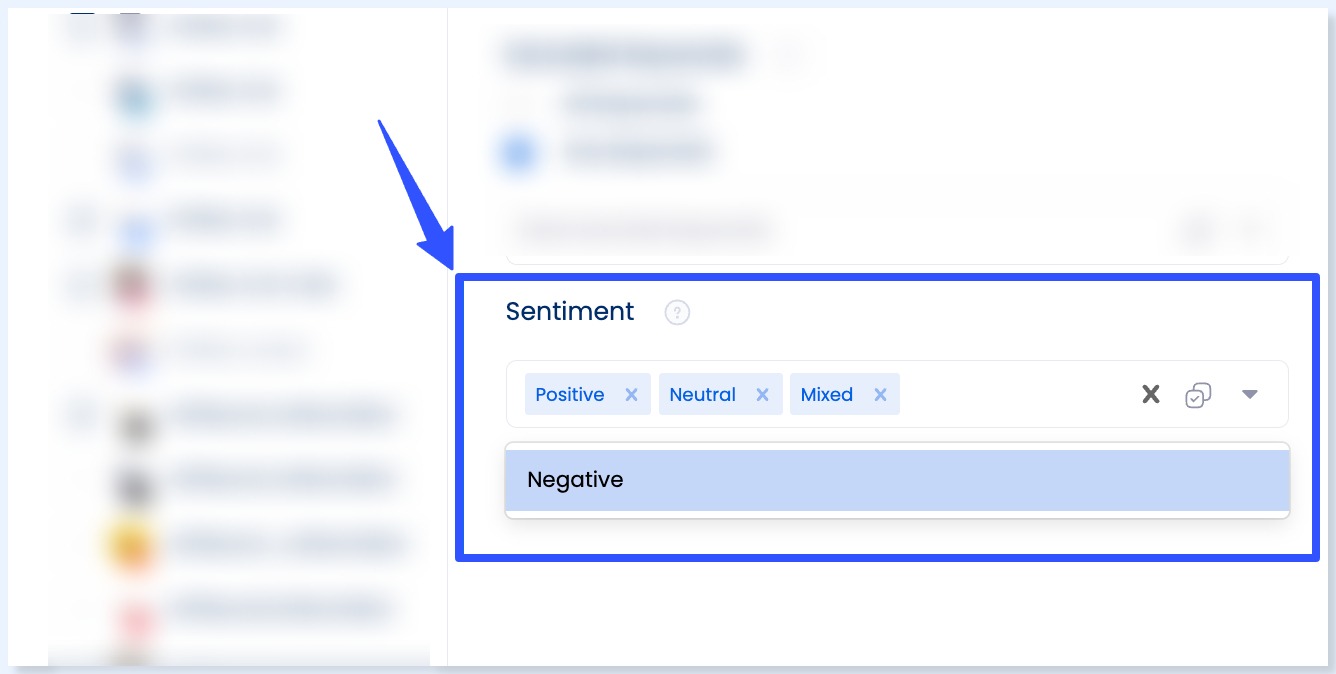
Vista Social’s Sentiment Analysis report can monitor audience emotions across all interactions in multiple social media platforms (via connected profiles).
The reports can show sentiment analysis of your clients’ DMs, comments, reviews, and mentions.
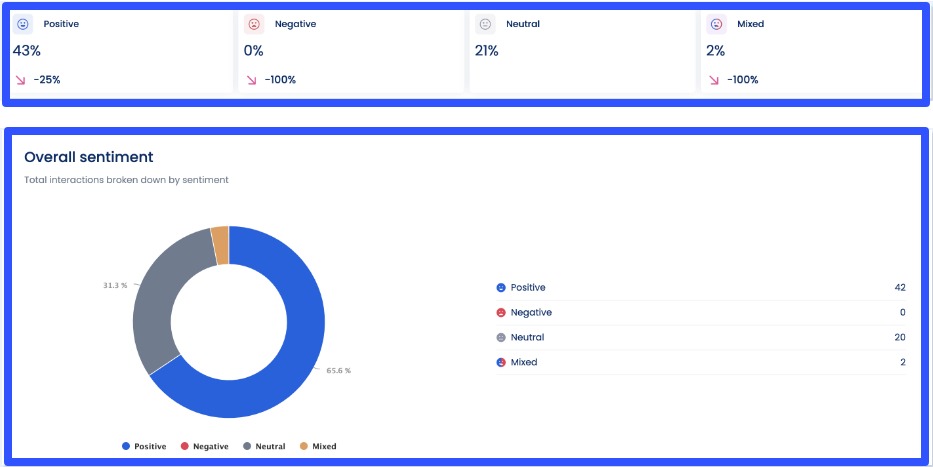
You can set the date range you want your sentiment analysis report to show.
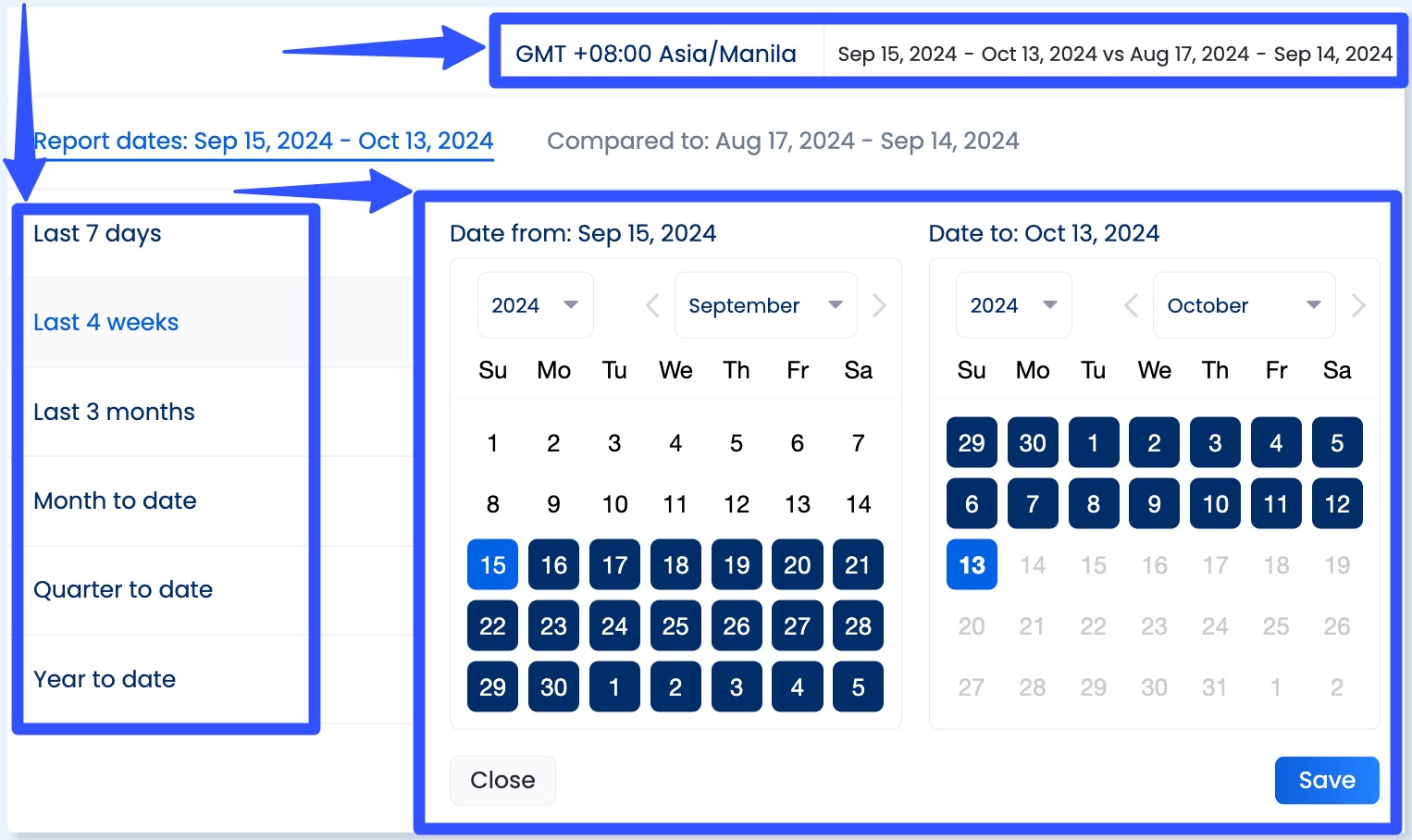
Must read: Social Media Sentiment Analysis vs Social Media Tracking
The Sentiment Analysis report dashboard includes the following metrics:
- Summary of sentiments
- Overall sentiment score (on a scale of – 10 to 10)
- Daily sentiment
- Count of total sentiments by type
- Public sentiment trends

Must read: Social Media Sentiment Analysis Dashboard: Tips & FAQs
The best part is that you can schedule your reports to auto-generate and share with your team members and clients.
You can share the reports via interactive links or export them to PDF or CSV and email them.
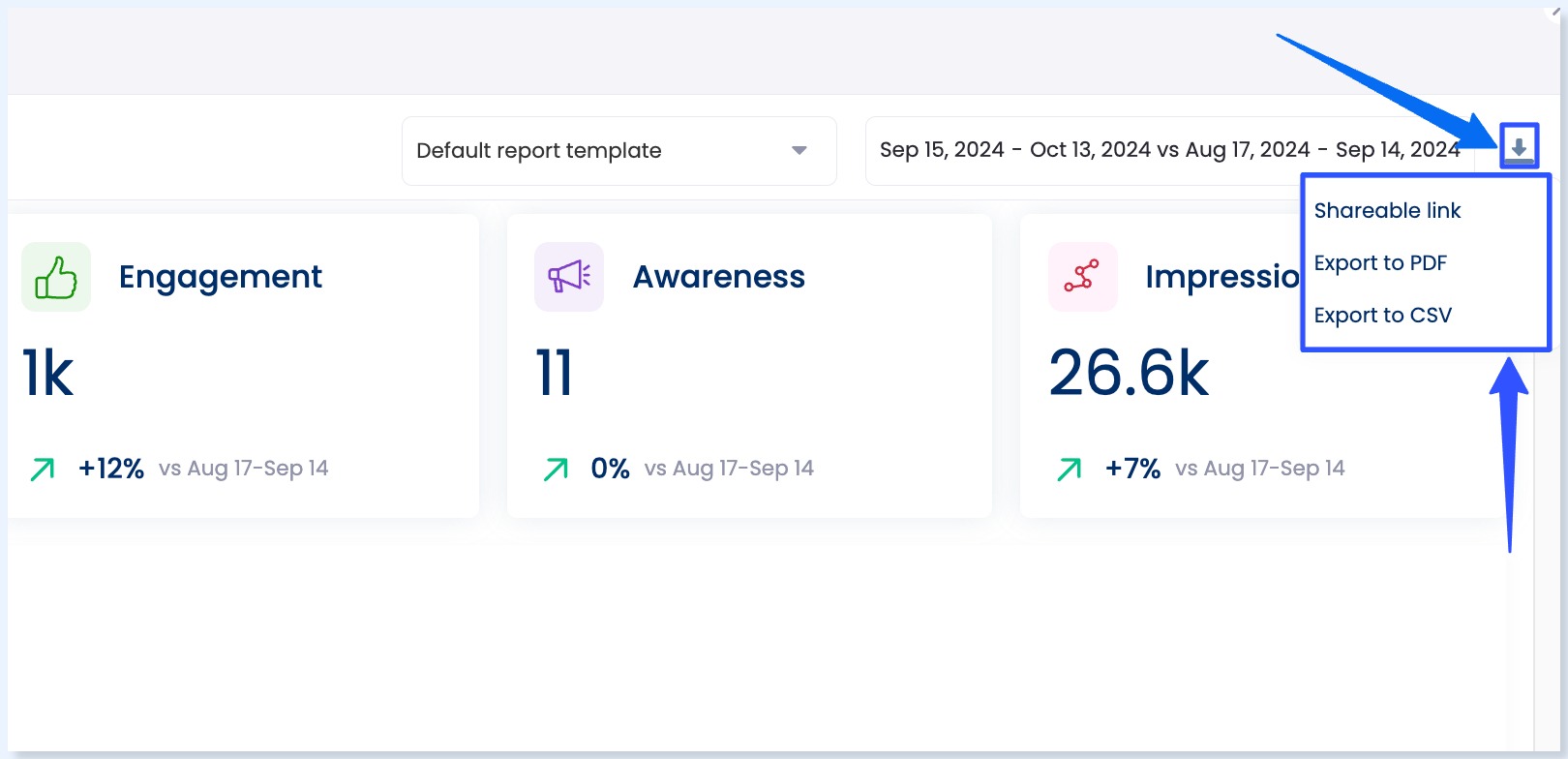
Don’t miss out on these other Vista Social features:
- Content scheduling, including post queuing and bulk publishing
- Content calendar
- AI Assistant
- Review management
- Social media analytics and reports
- Employee advocacy
- Post approval workflows
- Link in bio tool with customizable and brandable landing pages (Vista Page)
- Optimal posting time recommendations
- Etc.
FAQs on the benefits of social media sentiment analysis
How accurate is sentiment analysis?
It depends on your sentiment analysis tool.
However, while sentiment analysis tools are improving, sarcasm, slang, and context can affect accuracy.
Continuous refinement and combining automated tools with human oversight can enhance reliability.
Is sentiment analysis applicable only to large businesses?
No, businesses of all sizes can benefit from sentiment analysis to understand audiences better and improve engagement strategies.
How does sentiment analysis impact your marketing strategies?
It helps you tailor your marketing messages to resonate with the target audience’s emotions and preferences.
This can lead to more effective campaigns and improved brand perception.
Make the most of the benefits of social media sentiment analysis
Whether optimizing content, managing brand reputation, or proving ROI to clients, sentiment insights can give your social strategy the edge it needs.
Ready to see what your clients’ audiences think?
Start leveraging sentiment data with Vista Social—your all-in-one platform for smarter and faster social media management.
